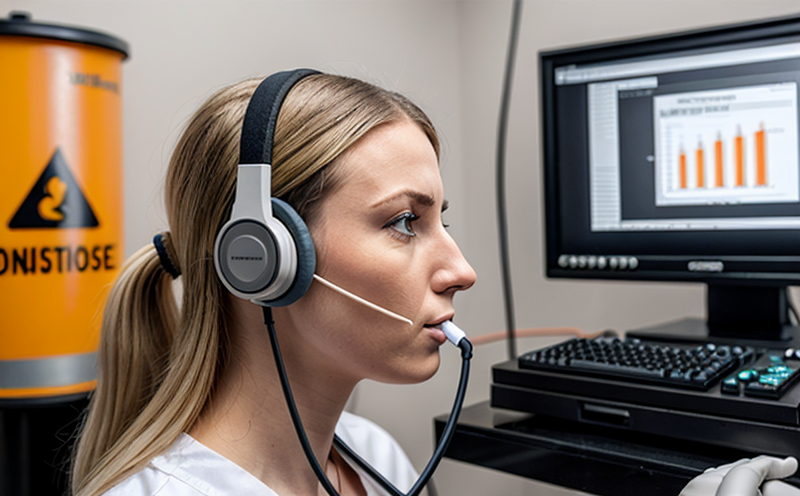OSHA Hearing Conservation Program Testing (Audiometry & Monitoring)
The Occupational Safety and Health Administration's (OSHA) hearing conservation program is a regulatory framework designed to protect workers from occupational noise-induced hearing loss. This service, OSHA Hearing Conservation Program Testing (Audiometry & Monitoring), involves the precise measurement of an individual’s auditory system through audiometric testing and continuous monitoring of their exposure levels to hazardous noise.
Auditory testing, commonly referred to as audiometry, is a key component in this program. Audiometry is conducted using specialized equipment that measures hearing sensitivity across various frequencies. The primary goal here is to identify any changes in an individual’s auditory thresholds over time. Continuous monitoring of noise exposure ensures that the workplace environment complies with OSHA standards and helps prevent excessive noise levels from causing harm.
The process begins with a comprehensive intake form where all relevant health information regarding previous hearing tests, medical history, and potential risk factors are gathered. This data is crucial for accurate interpretation of test results and personalized recommendations.
Testing typically involves the use of earphones or headphones connected to an audiometer. The patient listens to tones at different frequencies and volumes, and responds when they hear a sound. This provides valuable insights into how sensitive their ears are to various frequencies.
In addition to audiometric testing, continuous noise monitoring is conducted in the workplace using dosimeters. These devices record sound levels over extended periods, providing detailed information about the duration and intensity of noise exposure. This data is then analyzed against OSHA guidelines to ensure compliance with permissible exposure limits (PELs).
Our laboratory adheres strictly to international standards such as ISO 1999:2014 for audiometric testing procedures. We use state-of-the-art equipment and follow rigorous protocols to ensure accurate and reliable results. Our team of experienced professionals ensures that each test is conducted with precision, ensuring compliance with OSHA regulations.
The results of these tests are critical in determining the effectiveness of hearing protection devices (HPDs) provided by employers. If a worker’s hearing begins to deteriorate over time, it may indicate inadequate protection or excessive noise exposure. Regular audiometric testing allows for early detection of any issues, enabling timely interventions and adjustments.
Our service also includes providing detailed reports that summarize the results of both the audiometric tests and continuous noise monitoring. These reports are essential tools for employers to monitor their employees’ hearing health and ensure compliance with OSHA regulations. They serve as a foundation for developing effective hearing conservation programs, which include appropriate training, selection, and fitting of HPDs.
By implementing this service, organizations not only meet regulatory requirements but also demonstrate their commitment to worker safety and well-being. Regular monitoring helps prevent the progression of noise-induced hearing loss, thereby enhancing productivity and reducing absenteeism due to health issues.
Industry Applications
The OSHA Hearing Conservation Program Testing (Audiometry & Monitoring) is particularly relevant in industries where workers are exposed to high levels of noise on a regular basis. These include manufacturing, construction, mining, transportation, and healthcare sectors. In these environments, prolonged exposure to loud noises can lead to significant hearing damage if proper precautions aren’t taken.
In the manufacturing industry, for example, assembly lines often produce high decibel sounds which can be hazardous to workers’ health. Our service ensures that any potential risks are identified early through regular testing and monitoring. This allows manufacturers to implement necessary controls such as engineering solutions or administrative measures like rotating job assignments to mitigate these risks.
Construction sites present another challenging scenario due to the use of heavy machinery which generates intense noise levels. By adhering strictly to OSHA guidelines, we help construction companies maintain safe working environments while ensuring compliance with legal standards.
The mining sector also faces unique challenges related to underground operations where natural caverns amplify sound waves. Our expertise in this area ensures that miners’ hearing remains protected despite the harsh conditions they work under.
In healthcare settings like emergency departments or intensive care units, staff are frequently exposed to sirens and alarms. Regular testing helps protect these workers who spend long hours in noisy environments.
Transportation industry personnel such as pilots, ground crews, and train operators face similar challenges due to the nature of their jobs. Our service ensures that they too receive adequate protection against noise-induced hearing loss.
Quality and Reliability Assurance
The quality and reliability assurance processes in our OSHA Hearing Conservation Program Testing (Audiometry & Monitoring) are designed to ensure accuracy, consistency, and compliance with all relevant standards. We employ rigorous calibration procedures for our audiometric equipment to guarantee precise measurements every time.
- Calibration: All instruments used for audiometric testing undergo regular recalibration according to manufacturer specifications and industry best practices. This ensures that the devices remain accurate throughout their operational life.
- Data Validation: Each set of test results is cross-validated against previous records to detect any inconsistencies or anomalies. Any discrepancies are promptly investigated and corrected before final reports are generated.
- Training & Certification: Our team members undergo continuous training in the latest techniques and methodologies related to audiometric testing. They hold certifications from reputable organizations, ensuring they stay updated on best practices and advancements in this field.
We also maintain strict quality control measures during both the setup of monitoring equipment at job sites as well as conducting actual tests within our laboratories. These steps include thorough inspection procedures before each use to prevent errors or malfunctions that could affect test outcomes.
Our commitment to excellence extends beyond just technical aspects; we prioritize communication and transparency with all clients involved in this process. By keeping them informed about every step of the testing procedure, including any findings or recommendations made during audits, we foster trust between us and our clients.





